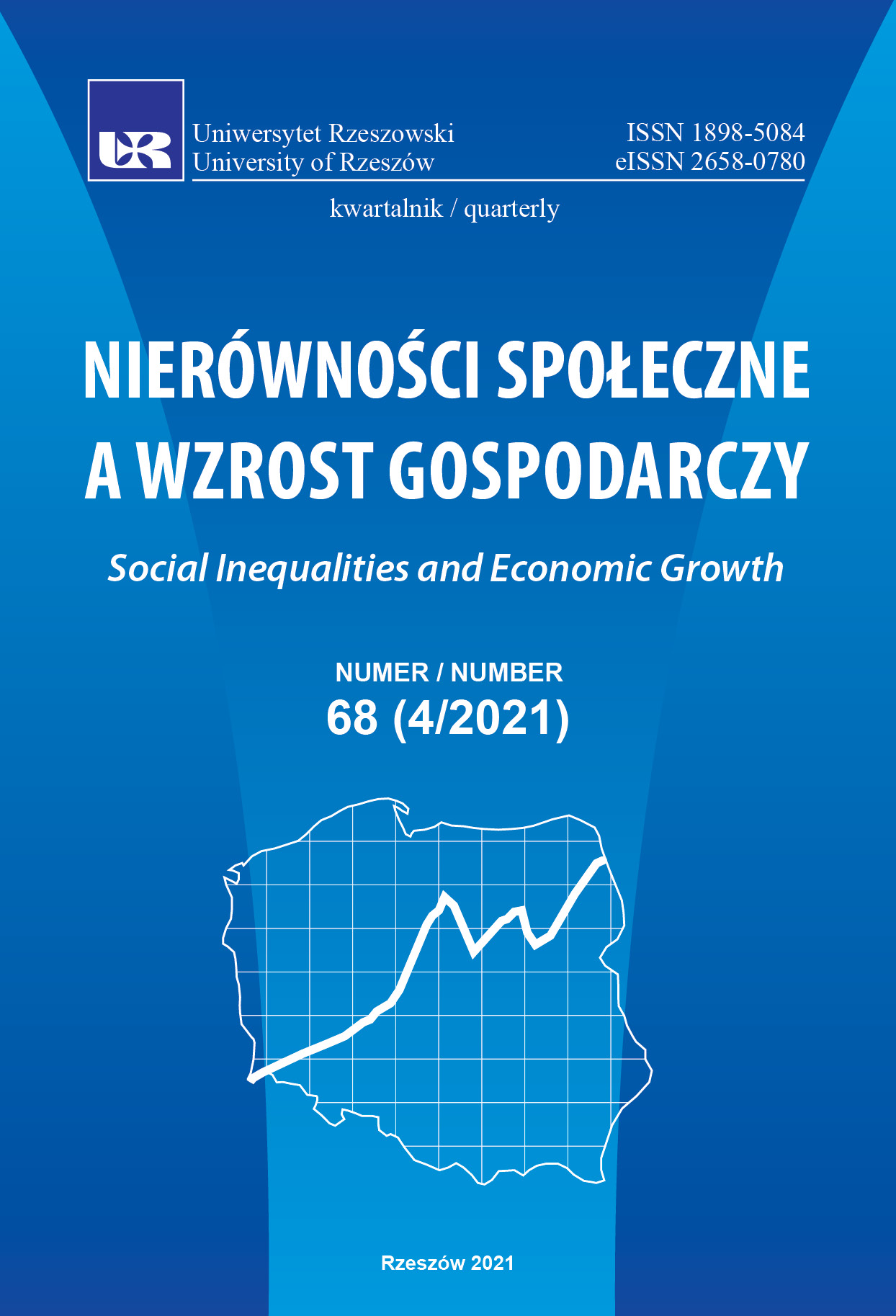Ewolucja nierówności dochodowych i majątkowych w Indiach w latach 1951–2019
DOI:
https://doi.org/10.15584/nsawg.2021.4.10Słowa kluczowe:
nierówności, Indie, kraje rozwijające sięAbstrakt
Coraz większa liczba badań i dostępnych danych wyraźnie wskazuje na wzrost poziomu nierówności na całym świecie w ciągu ostatnich 30–40 lat. W tym kontekście szczególny przypadek stanowią Indie ze względu na ogromne zróżnicowanie etniczne, językowe oraz specyficzne, powstałe w wyniku wiekowej ewolucji, instytucje społeczne. Praca dzieli się na trzy części. W pierwszej przybliżony zostaje problem nierówności we współczesnym świecie i relacji z procesami wzrostu gospodarczego. Druga część jest poświęcona 192 Michał Zaremba analizie nierówności w Indiach w latach 1951–1989, a trzecia analizuje ten problem od roku 1990. Artykuł kończy się zakończeniem, w którym syntetycznie przedstawiono wnioski z przeprowadzonych analiz. W pracy wykorzystywana jest przede wszystkim analiza historyczna bazującą na literaturze krajowej i zagranicznej oraz analiza danych zastanych. Zgodnie z przeprowadzaną analizą, w Indiach udziały poszczególnych percentyli w dochodzie i majątku otrzymywały się na względnie stałym poziomie w latach pięćdziesiątych, sześćdziesiątych i siedemdziesiątych XX wieku, przy czym udziały dla górnych warstw zmniejszały się w tym czasie nieznacznie. W istocie można zaobserwować faktyczną petryfikację tradycyjnych struktur i nierówności. Stan ten zmienił się w już połowie lat osiemdziesiątych, a znacząco przyspieszył na początku lat dziewięćdziesiątych XX wieku wraz z neoliberalnymi reformami opartymi o konsensus waszyngtoński. W efekcie w ciągu ostatnich 30 lat nastąpił znaczny wzrost poziomu nierówności. Oznaczałoby to, że pomimo ponad 70 lat reform gospodarczych, ostatecznie nie dało się zbudować silnego, egalitarnego społeczeństwa. W długiej perspektywie może to prowadzić nie tyle do utwierdzenia systemu demokratycznego, co powstania plutokracji w miejsce demokracji, a mocarstwowe ambicje New Delhi pozostaną na zawsze w sferze planów.
Downloads
Bibliografia
Acharya, S., Ahluwalia, I. J., Krishna, K. L., Patnaik, I. (2006). Economic Growth in India, 1950–2000. W: K. S. Parikh (red.), Explaining Growth in South Asia (s. 123–198). New Dehli: Oxford University Press.
Acocella, N. (2002). Zasady polityki gospodarczej. Warszawa: Wydawnictwo Naukowe PWN.
Ahluwalia, M. S. (2018). India’s Economic Reforms an Appraisal. Pobrane z: http://plan ningcommission.nic.in/aboutus/speech/spemsa/msa018.pdf (2019.09.12).
Alesina, A., Perotti, R. (1996). Income distribution, political instability, and investment. Eu ropean Economic Review, 40(6), 1203–1228. DOI: 10.1016/0014-2921(95)00030-5.
Alesina, A., Rodrik, D. (1994). Distributive politics and economic growth. Quarterly Journal of Economics, 109(2), 465–490. DOI: 10.2307/2118470.
Barro, R. J. (2000). Inequality and growth in panel of countries. Journal of Economic Growth, 5, 5–32. DOI: 10.1023/A:1009850119329.
Bywalec, G. (2015). Reformy ekonomiczne i polityczne a rozwój gospodarczy Indii 1991–2012. Łódź: Wydawnictwo Uniwersytetu Łódzkiego.
Chandra, B., Mukherjee, A., Mukherjee, M. (1999). India after Independence. New Dehli: Viking Penguin India.
Chen, S., Ravallion, M. (1997). What can new survey data tell us abort recent chang es in distribution and poverty? The World Bank Economic Review, 11(2), 357–382.DOI:10.1093/wber/11.2.357.
Deininger, K., Squire, L. (1996). A New Data Set Measuring Income Inequality. World Bank Economic Review, 10(3), 565–591. DOI:10.1093/wber/10.3.565.
Dollar, D., Kraay, A. (2002). Growth is good for the poor? Journal of Economic Growth, 7, 195–225. DOI: 10.1023/A:1020139631000.
Easterly, W. (1999). Life during growth. Journal of Economic Growth, 4(3), 239–276. DOI: 10.1023/A:1009882702130.
Ferreira, H. G. (1999). Inequality and economic performance. A brief overview to theories of growth and distribution. Pobrane z: https://citeseerx.ist.psu.edu/viewdoc/down load?doi=10.1.1.458.7810&rep=rep1&type=pdf (2021.07.10).
Fitoussi, P. J., Saraceno, F. (2010). Europe: how deep is a crisis? Policy responses and structural factors behind diverging performances. Journal of Globalization and Development, 1(1), 1–19. DOI: 10.2202/1948-1837.1053.
Forbes, K. (2000). A reassessment of the relation between inequality and growth. Ameri can Economic Review, 90(4), 869–897. DOI: 10.1257/aer.90.4.869.
IMF World Economic Outlook. Pobrane z: https://www.imf.org/en/publications/weo (2021.07.10).
Joshi, V., Little, I. M. D. (1996). India’s Economic Reforms 1991–2001. New Dehli: Ox ford University Press.
Kowalczyk, S. (2016). Kilka uwag w sprawie teorii nierówności. Kwartalnik Nauk o Przedsiębiorstwie, 6(4), 15–26.
Kumar, Ch. (2011). A discursive dominance theory of economic reforms sustainability: the case of India. India Review, 10(2), 126–184. DOI: 10.1080/14736489.2011.574550.
Kumar, N. P., Ladusingh, L. (2019). Discovering the Saga of Inter-caste Marriage in India.
Journal of Asian and African Studies, 54(4), 588–599. DOI: 10.1177/0021909619829896.
Li, H., Zou, H. (1998). Income inequality is not harmful for growth: theory and evidence. Review of Development Economics, 2(3), 318–334. DOI: 10.1111/1467-9361.00045.
Lopez, J. H. (2004). Pro-poor, pro-growth: Is there a trade off? The World Bank Policy Research Working Paper, 3378. Pobrane z: https://openknowledge.worldbank.org/bit stream/handle/10986/14124/WPS3378.pdf?sequence=1&isAllowed=y (2021.07.10).
Maddison, A. (2006). The World Economy. Historical Statistics. Paris: Development Centre of the Organisation for Economic Co-operation and Development.
Perotti, R. (1996). Growth, income distribution, and democracy: what the data say. Journal of Economic Growth, 1(2), 149–187.
Piketty, T. (2015). Kapitał w XXI wieku. Warszawa: Wydawnictwo Krytyki Politycznej.
Putnam, R. D. (2000). Bowling alone: The collapse and revival of American community. New York: Simon and Schuster.
Srinivas, Sh.V. (2018). The economic history of India. India and the International Monetary Fund 1944–2017. Pobrane z: http://nationalarchives.nic.in/sites/default/files/new/THE%20ECONOMIC%20HISTORY%20OF%20INDIA.pdf (2019.08.10).
Srinivasan, T. N. (2000). Eight Lectures on India’s Economic Reforms. New Dehli: Oxford University Press.
Stiglitz, J. E. (2004). Ekonomia sektora publicznego. Warszawa: Wydawnictwo Naukowe PWN.
Stiglitz, J. E. (2015). Cena nierówności. W jaki sposób podziały społeczne zagrażają naszej przyszłości. Warszawa: Wydawnictwo Krytyki Politycznej.
Therborn, G. (2015). Nierówność, która zabija. Jak globalny wzrost nierówności niszczy życie milionów i jak z tym walczyć? Warszawa: Wydawnictwo Naukowe PWN.
Virmani, A. (2001). India’s 1990–91 crisis: reforms, myths and paradoxes. Working Paper, No. 4/2001-Planning Commission.
World Bank Data Base. Pobrane z: https://data.worldbank.org/ (2021.07.10).
World Inequality Database. Pobrane z: https://wid.world/country/india/ (2021.07.10).
Woźniak, M. G. (2014). Nierówności społeczne a rozwój gospodarczy. W: B. Kłos, J. Szymańczak (red.), Nierówności społeczne w Polsce (s. 9–47). Warszawa: Wydawnictwo Sejmowe.
Żuławska, U. (2011). Finansowanie wzrostu gospodarczego. W: R. Piasecki (red.), Ekonomia rozwoju (s. 94–100). Warszawa: Polskie Wydawnictwo Ekonomiczne, Warszawa.
Pobrania
Opublikowane
Jak cytować
Numer
Dział
Licencja

Utwór dostępny jest na licencji Creative Commons Uznanie autorstwa – Na tych samych warunkach 4.0 Miedzynarodowe.


